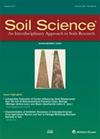Long-term impact of cover crop and reduced disturbance tillage on soil pore size distribution and soil water storage
4区 农林科学
Q2 Agricultural and Biological Sciences
引用次数: 8
Abstract
Abstract. We studied the long-term impact of contrasting tillage and cover cropping systems on soil structure and hydraulic properties. Complete water retention and conductivity curves for the top (0–5 cm) and subsurface (20–25 cm) soils were characterized and contrasted. Dynamic water storage and retention were evaluated using numerical simulations in HYDRUS-2D software. Compared with standard-till (ST) and no-cover-crop (NO) systems, soils under no-till (NT) and cover cropping (CC) systems showed improved soil structure in terms of pore size distribution (PSD). Changes in hydraulic conductivity (K) under these systems led to an increased infiltration rate and water retention. However, NT and CC plots had lower water content at field capacity (33 kPa suction) and lower plant-available water (PAW) compared with ST and NO plots. Numerical simulations, however, showed that NT and CC plots have higher water storage (albeit marginal in magnitude) and water availability following irrigation. Because the numerical simulations considered retention and conductivity functions simultaneously and dynamically through time, they allow the capture of hydraulic states that are arguably more relevant to crops. The study concludes that the long-term practices of NT and CC systems were beneficial in terms of changes to the PSD. NT and CC systems also marginally improved soil water conductivity and storage at the plot scale.覆盖作物和减少干扰耕作对土壤孔隙大小分布和土壤水分储存的长期影响
摘要我们研究了对比耕作和覆盖耕作制度对土壤结构和水力特性的长期影响。对表层(0-5 cm)和地下(20-25 cm)土壤的完整保水和电导率曲线进行了表征和对比。在hydrus - 2d软件中进行数值模拟,评估了动态储水和保水性。与标准耕作(ST)和不覆盖作物(NO)制度相比,免耕(NT)和覆盖作物(CC)制度下的土壤在孔隙大小分布(PSD)方面表现出改善的结构。在这些体系下,水导率(K)的变化导致了渗透速率和水潴留的增加。然而,与ST和NO地块相比,NT和CC地块的田间吸力(33 kPa)和植物有效水分(PAW)较低。然而,数值模拟表明,ntt和CC地块在灌溉后具有更高的储水量(尽管幅度不大)和水分可利用性。由于数值模拟同时动态地考虑了保留和电导率功能,因此它们允许捕获与作物更相关的水力状态。该研究的结论是,就psd的变化而言,NT和CC系统的长期实践是有益的。在样地尺度上,NT和CC系统也略微改善了土壤的导电性和储水量。
本文章由计算机程序翻译,如有差异,请以英文原文为准。
求助全文
约1分钟内获得全文
求助全文
来源期刊

Soil Science
农林科学-土壤科学
CiteScore
2.70
自引率
0.00%
发文量
0
审稿时长
4.4 months
期刊介绍:
Cessation.Soil Science satisfies the professional needs of all scientists and laboratory personnel involved in soil and plant research by publishing primary research reports and critical reviews of basic and applied soil science, especially as it relates to soil and plant studies and general environmental soil science.
Each month, Soil Science presents authoritative research articles from an impressive array of discipline: soil chemistry and biochemistry, physics, fertility and nutrition, soil genesis and morphology, soil microbiology and mineralogy. Of immediate relevance to soil scientists-both industrial and academic-this unique publication also has long-range value for agronomists and environmental scientists.
 求助内容:
求助内容: 应助结果提醒方式:
应助结果提醒方式:


